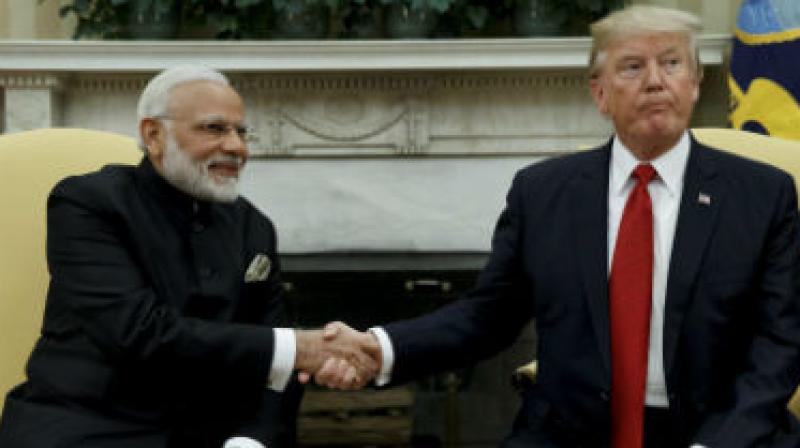New Delhi must learn to play a balancing' game

US secretary of state Rex Tillerson arrives in India later this week, just after Afghan President Ashraf Ghani. Last month, India had hosted US defence secretary James Mattis. Although US President Donald Trump will bypass India on his five-nation Asian jamboree, from November 3 to 14, the visits of two major US Cabinet secretaries underlines Washing-ton’s continued interest in US-India relations. The presence of the Afghan President remi-nds us that when Pres-ident Trump announced his new Afghan policy on August 21, he, after detailed analysis, emphasised the larger South Asian context and the need for a regional solution while, of course, applying military pressure on the Taliban and their cohorts. The United States realises that Afghanistan simply can’t be stabilised unless the regional powers are on board. On October 16, the US convened the Quadrilateral Coordination Group, that comprises Afghanistan, China, Pakistan and the US, in Muscat to kickstart the reconciliation process in Afghanistan. The US proposes to widen the discussion with the involvement of other regional powers. The inhibiting factor is the deterioration of Iran-US relations, which will inevitably impinge on an Iranian role, considering its open channels to the Taliban.
Mr Tillerson provided the curtainraiser when he spoke on October 18, at the Centre for Strategic and International Studies in Washington. He saw India as a partner for “far-reaching implications for the next 100 years”. He called the US and India the “bookends of stability”, with the potential to be “increasingly global partners with strategic convergence”. The intent became apparent when he compared the rise of India as a peaceful, democratic power abiding by the existing “rules-based system” to the rise of China, trying to rewrite parts of the same system in keeping with Chinese interests and historical predilections. China, seen as a challenge, has evolved much since the presidency of George W. Bush when it was an unstated factor behind a nuclear deal with India. This reverses the US policy on China crafted by President Richard Nixon after his 1972 China visit, arguing that China, with access to Western capital and technology, would inevitably become a more open and productive member of the international system. Mr Tillerson is now declaring that China needs to be contained the way the erstwhile USSR was during the Cold War, the difference being that there cannot be unbridled opposition as Sino-US relations rest on tremendous linkages of trade and investment. For instance, while President Trump will engage President Xi, he has, meanwhile, ordered Robert Lighthizer, the US trade representative, to investigate, under Section 301 of the 1974 US Trade Act, China’s “unfair trade practices”. Mike Pompeo, director of the CIA, provided the counterpoint with his remark that China has shown real progress in the DPR Korea (North Korea) issue, and as Chinese President Xi Jinping consolidates more power he also gains the capacity to do more good.
Chinese President Xi Jinping, in his address to the 19th Party Congress at the Great Hall of the People in Beijing, restated Chinese prescriptions for an Asian security order. He said it must be all-inclusive, based on regional integration and development and not on absolute security for any single country. The target was clearly the US as it is the current offshore guarantor of Asian security. China, on the other hand, wishes to construct, using the Belt and Road Initiative (BRI), a Sino-centric order. Mr Tillerson used his CSIS address to debunk BRI by arguing, as India has in the past, that the region really needs “alternative financing measures” for infrastructure development. BRI, unlike project financing by the World Bank, he reasoned, overlooked poor governance, environmental and humanitarian questions arising in the nations and regions it traversed. In joint statements with India in the past, the US had flagged the breach of sovereignty of some nations. But the question remains about the source of alternative funding. Mr Trump’s “America First” slogan implies rhetorical support combined with exhortations to regional powers to fund their own defence or development.India, reared on nonalignment, has to make policy choices in how and to what extent to rely on the Trump-tweaked US doctrines.
It is true that the convergence of interests between India and Australia, Japan and the US is for India as a potential tool to shape its Asian environment. Mr Tillerson correctly emphasised the importance of bilateral India-US relations as evidenced by two-way trade touching $115 billion last year, the US having over 600 companies in India and hosting 166,000 students in the United States. The path has been also cleared for the transfer of cutting-edge technology in the field of defence, among other areas. Cooperation in counter-terrorism has expanded exponentially since I dealt with it as coordinator for counterterrorism in 2005-07. But President Trump’s visa policy is a new hurdle stymieing the free flow of human resources and has hurt the export of Indian software and services.
From this complex scenario, India has to devise a policy to play the new balancing game between the powers of the Indo-Pacific, consisting of China and Russia on one side and India, Japan and the US on the other. India is, as was a rising Germany in the 19th century, a swing power that can work with the other four.
Mr Trump’s Asian sojourn shows his immediate priority is to defang North Korea and rebalance relations with China. The moral for the Narendra Modi government is that it must regain the trust of the Opposition and rebuild a national consensus. A united India abiding by its liberal values as enshrined in the Constitution is the counterweight to an assertive China. Swing powers need soft, hard and smart power to win allies and thwart foes. Germany did that under Chancellor Otto von Bismarck. Under lesser men who followed, Europe slipped towards the world wars. South Asia and beyond countenance the same dilemma.

